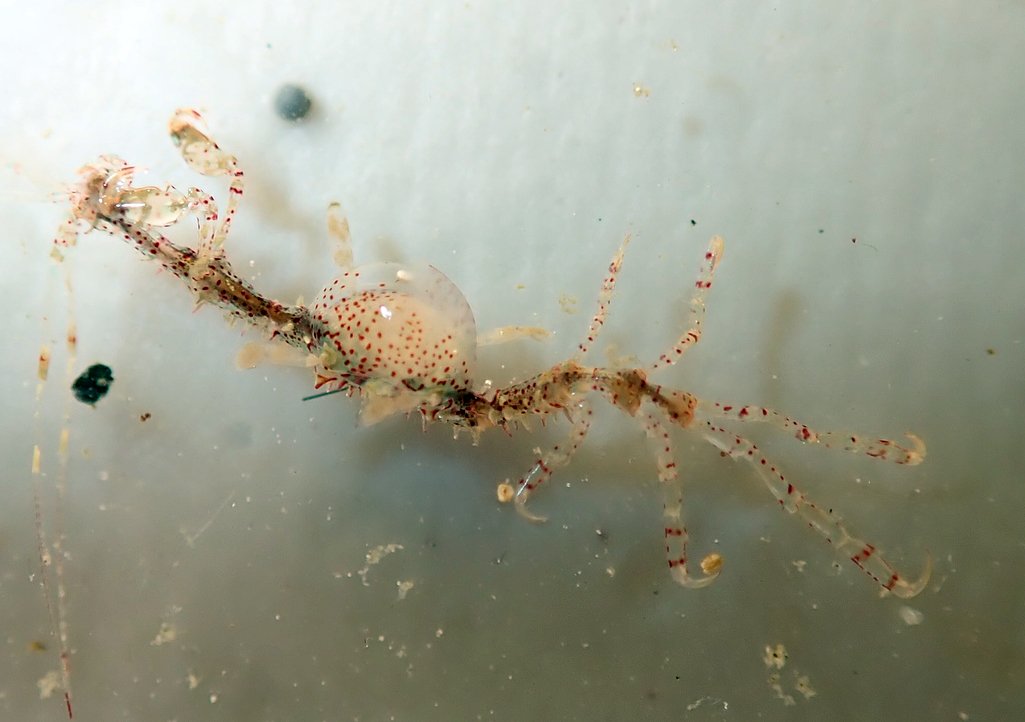Antranig Basman, Charlie Gibbs, Donna Gibbs, Emily Adamczyk, Andy Lamb, Andrew Simon
Aug 7th, 2023
Galiano Island’s crustacean diversity
The name ‘Crustacea’ is rooted in the Modern Latin ‘crusta’, meaning “shell.”
Crustacea are a highly diverse subphylum of Arthropoda that contains over 52,000 described terrestrial, marine and freshwater species. This subphylum includes six classes, three of which are represented locally: Hexanauplia (barnacles, copepods and tantulocarids); Ichthyostraca (fish lice); and Malacostraca (amphipods, crabs, isopods, krill and shrimp). Over 900 marine crustacean species are known to occur in British Columbia. Of these, 93 species have been reported for Galiano Island, through the combined efforts of more than 15 individuals.
Numerous non-native crustaceans are known to the region, though only one introduced species is currently represented in the Galiano Island record. The introduced Japanese skeleton shrimp (Caprella mutica), reported for Galiano Island, is now well established along the coast of British Columbia. The invasive European green crab (Carcinus maenas) and two tanaids, Leptochelia dubia and Zuexo normani, have been found off Vancouver Island, but are not yet known locally. Additionally, the non-native amphipods Ampithoe valida, Caprella drepanochir, Incisocalliope derzhavini, Melita nitida, Monocorophium acherusicum, Monocorophium insidiosum, and Jassa slatteryi, along with the bay barnacle Amphibalanus improvisus, have all been reported in the Strait of Georgia, but have not yet been reported for Galiano Island.

Caprella mutica – Photograph by Emily Adamczyk
Community science contributions
Since the Biodiversity Galiano project began in 2016, our community has documented 56 crustacean species in the waters around Galiano Island, confirming 53 percent of the historical records and adding 14 new species to the list. Of the 79 historically reported taxa, 37 species remain unconfirmed, having gone unreported in the last twenty years.
Many crustaceans are difficult to identify without microscopy, contributing to biases in the local record. Locally, ichthyostracan crustaceans are vastly under-represented and cladocerans and ostracods remain unrepresented to date. As of yet, there are no records of hoplocarids (mantis shrimps), ascothoracids or tantulocarids occurring within British Columbia. The latter two groups will likely be discovered with further investigation; hoplocarids, however, have never been observed north of southern California and are unlikely to occur in the region. Leptostracans are not well described, though at least one species from the genus Nebalia is known to the Northeast Pacific. Closer examination of subtidal and intertidal eelgrass, algae wrack and the rocky intertidal zone will uncover many unrecorded taxa.
Crustaceans with Indigenous cultural significance
Crustaceans are one of many phyla that have cultural significance to Hul’qumi’num speaking peoples. Generally, crustaceans are regarded as important food sources for delicacy and cultural practice.
Giant Barnacle, known in Hul’qumi’num as Qumine’ Qumine’ is regarded as an important and tasty delicacy, roasting them by fire making them an easier delicacy to enjoy.
Red Rock Crab, known in Hul’qumi’num as Kwakwatl’shun Kwakwatl’shun is easier to find but provides less meat for the effort, hence, they are generally not a preferred species to consume but one consumed in times of need.
Dungeness Crab, known in Hul’qumi’num as Ey’x Ey’x is an important food source, traditionally harvested with a 3-pronged spear. Some Elders have harvested ey’x by stepping (’umutsun) on ey’x barefoot and then placing them in a basket or canoe.
Pacific Prawn, known in Hul’qumi’num as Mam’ul’ or Maal-mul’ Mam’ul’are is the largest shrimp species in the North Pacific, reaching lengths of up to 25 cm. There is limited cultural information about Mam’ul’, just that the Hul’qumi’num name has been documented.
Top community contributions to our knowledge of the island crustacean diversity
Here, you can browse photos of crustacean species commonly documented around Galiano Island, as well as recent observations, most favourited observations, and top observers, based on iNaturalist data. Please help contribute to the growing record of the island crustacean diversity by submitting your observations to the Biodiversity Galiano iNaturalist project..